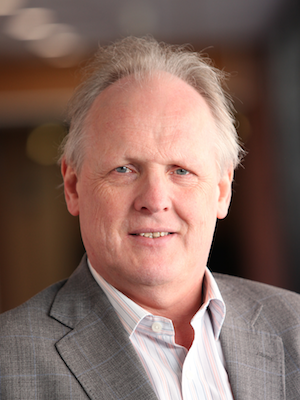Go to
Steve Furber

Professor
Advanced Processors Technologies Research Group
School of Computer Science
University of Manchester, Manchester, UK
Biologically-Inspired Massively-Parallel Computation
The SpiNNaker (Spiking Neural Network Architecture) machine is a massively-parallel computer whose interconnect fabric is based upon the observed characteristics of spiking communications in the mammalian brain. The machine will ultimately incorporate over a million ARM processor cores operating in an asynchronous event-driven mode, each core modelling up to a thousand spiking point-neuron models operating in biological real time. The goal of the machine is to create a generic platform for real-time large-scale spiking neural networks where the precise details of the neural model and the synaptic plasticity rule are defined in software, so a range of different neuron types and plasticity rules can be accommodated, including heterogeneous models.
The key to modelling real-time spiking neural networks is in the communication fabric that conveys spikes from one neuron to another. The brain is highly connected, with typical fan-in and fan-out numbers up to 10,000, and in some cases higher. SpiNNaker represents each neuron spike as a small packet using address event representation, where the major content of each packet is simply a 32-bit identifier of the neuron the generated the spike. These packets are then conveyed through a multicast packet-switched fabric, employing a packet router on each 18-core chip to direct each packet to any or all of the local cores and to any or all of the routers on neighbouring chips. The router uses the source identifier and an associative look-up table to perform this task. All packet routing is carried out in hardware which, combined with the small packet size, enables the system to have low packet latency and high packet throughput, supporting biologically-realistic spike rates with a fully configurable network topology.
The resulting system is a highly-flexible platform for modelling complex networks of functions that are coupled through asynchronous events. Although primarily intended for spiking neural networks, the architecture is proving useful for a wider range of applications, including modelling Bayesian networks, finite element problems, path- and ray-traced graphics, and many others. The biological imperative to model the very high connectivity of the brain has led us to an unusual architecture which, while not as general-purpose as a conventional parallel supercomputer, is much simpler and cheaper, and does appear to be effective across a number of application areas.
About the speaker:
Steve Furber was born in Manchester, UK, in 1953. He received a BA in mathematics (1974) and a PhD in aerodynamics (1980) from the University of Cambridge, UK, and has received honorary doctorates from Edinburgh University (2010) and Anglia Ruskin University (2012). From 1978 to 1981 he was Rolls Royce Research Fellow in aerodynamics at Emmanuel College Cambridge, and from 1981 to 1990 he was at Acorn Computers Ltd, Cambridge, UK, where he was a principal architecture of the BBC Microcomputer, which introduced computing into most UK schools, and the ARM 32-bit RISC microprocessor, over 50 billion of which have been shipped by ARM Ltd’s partners. In 1990 he moved to the ICL Chair in Computer Engineering at the University of Manchester where his research interests include asynchronous digital design, low-power systems-on-chip and neural systems engineering. He is a Fellow of the Royal Society, the Royal Academy of Engineering, the IEEE, the British Computer Society, the Institution of Engineering and Technology and the Computer History Museum (Mountain View, CA). He was a Millenium Technology Prize Laureate (2010) and holds an IEEE Computer Society Computer Pioneer Award (2013).
Secondary navigation
- EPFL Workshop on Logic Synthesis and Emerging Technologies
- Luca Amaru
- Luca Benini
- Giovanni De Micheli
- Srini Devadas
- Antun Domic
- Rolf Drechsler
- Pierre-Emmanuel Gaillardon
- Jie-Hong Roland Jiang
- Akash Kumar
- Shahar Kvatinsky
- Yusuf Leblebici
- Shin-ichi Minato
- Alan Mishchenko
- Vijaykrishnan Narayanan
- Ian O'Connor
- Andre Inacio Reis
- Martin Roetteler
- Julien Ryckaert
- Mathias Soeken
- Christof Teuscher
- Zhiru Zhang
- Symposium on Emerging Trends in Computing
- Layout synthesis: A golden DA topic
- EPFL Workshop on Logic Synthesis & Verification
- Luca Amaru
- Luca Benini
- Robert Brayton
- Maciej Ciesielski
- Valentina Ciriani
- Jovanka Ciric-Vujkovic
- Jason Cong
- Jordi Cortadella
- Giovanni De Micheli
- Antun Domic
- Rolf Drechsler
- Henri Fraisse
- Paolo Ienne
- Viktor Kuncak
- Enrico Macii
- Igor Markov
- Steven M. Nowick
- Tsutomu Sasao
- Alena Simalatsar
- Leon Stok
- Dirk Stroobandt
- Tiziano Villa
- Symposium on Emerging Trends in Electronics
- Raul Camposano
- Anantha Chandrakasan
- Jo De Boeck
- Gerhard Fettweis
- Steve Furber
- Philippe Magarshack
- Takayasu Sakurai
- Alberto Sangiovanni-Vincentelli
- Ken Shepard
- VENUE
- Panel on Circuits in Emerging Nanotechnologies
- Panel on Emerging Methods of Computing
- Panel on The Role of Universities in the Emerging ICT World
- Panel on Design Challenges Ahead
- Panel on Alternative Use of Silicon
- Nano-Bio Technologies for Lab-on-Chip
- Functionality-Enhanced Devices Workshop
- More Moore: Designing Ultra-Complex System-on-Chips
- Design Technologies for a New Era
- Nanotechnology for Health
- Secure Systems Design
- Surface Treatments and Biochip Sensors
- Security/Privacy of IMDs
- Nanosystem Design and Variability
- Past Events Archive
